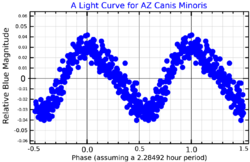Astronomy:AZ Canis Minoris
| Observation data Equinox J2000.0]] (ICRS) | |
|---|---|
| Constellation | Canis Minor |
| Right ascension | 07h 44m 07.63294s[2] |
| Declination | +02° 24′ 19.5226″[2] |
| Apparent magnitude (V) | 6.46[3] (6.44 to 6.51)[4] |
| Characteristics | |
| Spectral type | A5 IV[5] |
| B−V color index | 0.211±0.008[3] |
| Variable type | δ Sct[6] |
| Astrometry | |
| Radial velocity (Rv) | +14.9±0.9[3] km/s |
| Proper motion (μ) | RA: −18.963[2] mas/yr Dec.: −8.672[2] mas/yr |
| Parallax (π) | 6.5237 ± 0.1107[2] mas |
| Distance | 500 ± 8 ly (153 ± 3 pc) |
| Absolute magnitude (MV) | 1.01[3] |
| Details | |
| Mass | 1.91[7] M☉ |
| Radius | 3.83+0.20 −0.17[2] R☉ |
| Luminosity | 48.4±1.0[2] L☉ |
| Surface gravity (log g) | 3.6[8] cgs |
| Temperature | 7,783+138 −201[2] K |
| Metallicity [Fe/H] | 0.12[9] dex |
| Rotational velocity (v sin i) | 44[10] km/s |
| Age | 990[7] Myr |
| Other designations | |
| Database references | |
| SIMBAD | data |
AZ Canis Minoris is a variable star in the equatorial constellation of Canis Minor. It is just visible to the naked eye in good viewing conditions as a dim, white-hued star with an apparent visual magnitude of around 6.46.[3] The star is located around 500 light years away from the Sun based on parallax, and is drifting further away with a radial velocity of +15 km/s.[3] No evidence has been found for a companion to this star,[12] although in the past it has been reported as a binary star system.[13]
This star has a stellar classification of A5 IV,[5] matching an A-type subgiant star. The variable nature of this star was discovered in 1970 at Kitt Peak Observatory.[14] It is a monoperiodic Delta Scuti variable[8] with a cycle period of 2.29 hours and an amplitude of 0.060 in visual magnitude;[6] ranging from a peak magnitude of 6.44 down to 6.51.[4] AZ Canis Minoris is nearly a billion[7] years old with a projected rotational velocity of 44 km/s.[10] It has 1.9[7] times the mass of the Sun and 3.8[2] times the Sun's radius. The star is radiating 48[2] times as much luminosity as the Sun from its photosphere at an effective temperature of 7,783 K.[2]
References
- ↑ Poretti, E.; Mantegazza, L.; Bossi, M. (August 1996). "The stability of the frequency content in the light curves of the δ Scuti stars HD16439=V663 Cassiopeiae, AZ Canis Minoris, HD 223480=BF Phoenicis". Astronomy & Astrophysics 312: 912–918. Bibcode: 1996A&A...312..912P. https://ui.adsabs.harvard.edu/abs/1996A&A...312..912P. Retrieved 12 November 2021.
- ↑ 2.00 2.01 2.02 2.03 2.04 2.05 2.06 2.07 2.08 2.09 2.10 Brown, A. G. A. (August 2018). "Gaia Data Release 2: Summary of the contents and survey properties". Astronomy & Astrophysics 616: A1. doi:10.1051/0004-6361/201833051. Bibcode: 2018A&A...616A...1G. Gaia DR2 record for this source at VizieR.
- ↑ 3.0 3.1 3.2 3.3 3.4 3.5 Anderson, E.; Francis, Ch. (2012). "XHIP: An extended hipparcos compilation". Astronomy Letters 38 (5): 331. doi:10.1134/S1063773712050015. Bibcode: 2012AstL...38..331A.
- ↑ 4.0 4.1 "AZ CMi". International Variable Star Index. AAVSO. 4 January 2010. http://www.aavso.org/vsx/index.php?view=detail.top&oid=5593. Retrieved 14 January 2013.
- ↑ 5.0 5.1 Houk, N.; Swift, C. (1999). "Michigan catalogue of two-dimensional spectral types for the HD Stars". Michigan Spectral Survey 5. Bibcode: 1999MSS...C05....0H.
- ↑ 6.0 6.1 Rodríguez, E. et al. (June 2000). "A revised catalogue of delta Sct stars". Astronomy and Astrophysics Supplement 144 (3): 469–474. doi:10.1051/aas:2000221. Bibcode: 2000A&AS..144..469R.
- ↑ 7.0 7.1 7.2 7.3 Luck, R. Earle (2015). "Abundances in the Local Region. I. G and K Giants". The Astronomical Journal 150 (3): 88. doi:10.1088/0004-6256/150/3/88. Bibcode: 2015AJ....150...88L.
- ↑ 8.0 8.1 Poretti, E. et al. (August 1996). "The stability of the frequency content in the light curves of the δ Scuti stars HD16439=V663 Cassiopeiae, AZ Canis Minoris, HD 223480=BF Phoenicis". Astronomy and Astrophysics 312: 912−918. Bibcode: 1996A&A...312..912P.
- ↑ Netopil, Martin (August 2017). "Metallicity calibrations for dwarf stars and giants in the Geneva photometric system". Monthly Notices of the Royal Astronomical Society 469 (3): 3042–3055. doi:10.1093/mnras/stx1077. Bibcode: 2017MNRAS.469.3042N.
- ↑ 10.0 10.1 Bush, Tabitha C.; Hintz, Eric G. (September 2008). "Rotational Velocity Determinations for 118 δ Scuti Variables". The Astronomical Journal 136 (3): 1061–1066. doi:10.1088/0004-6256/136/3/1061. Bibcode: 2008AJ....136.1061B.
- ↑ "AZ CMi". SIMBAD. Centre de données astronomiques de Strasbourg. http://simbad.u-strasbg.fr/simbad/sim-basic?Ident=AZ+CMi.
- ↑ Liakos, Alexios; Niarchos, Panagiotis (February 2017). "Catalogue and properties of δ Scuti stars in binaries". Monthly Notices of the Royal Astronomical Society 465 (1): 1181–1200. doi:10.1093/mnras/stw2756. Bibcode: 2017MNRAS.465.1181L.
- ↑ Szatmary, Karoly (June 1990). "Pulsating Variable Stars in Binary Systems". The Journal of the American Association of Variable Star Observers 19 (1): 52–56. Bibcode: 1990JAVSO..19...52S.
- ↑ Percy, J. R. (July 1970). "HR 2989: a New Delta Scuti Star". Information Bulletin on Variable Stars 444: 1. Bibcode: 1970IBVS..444....1P.
 |


